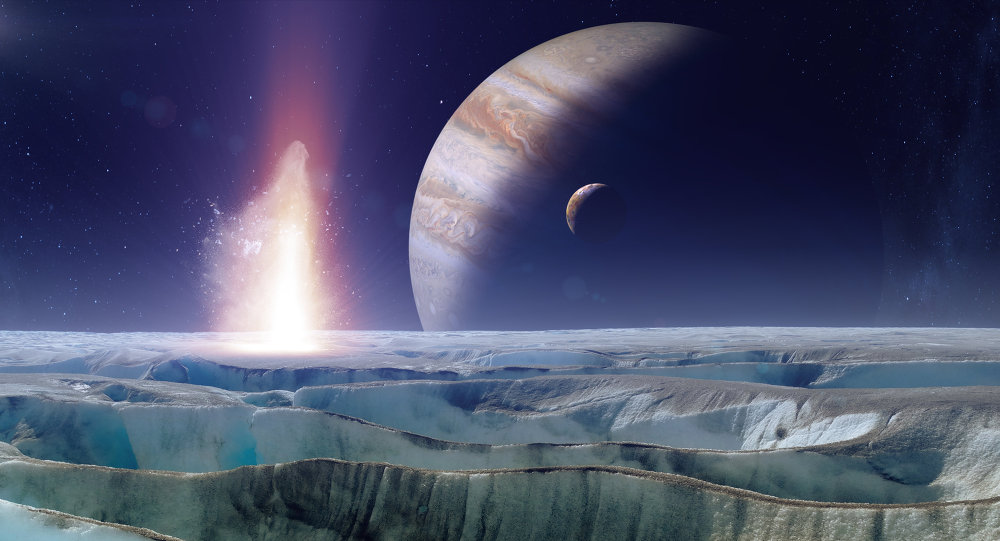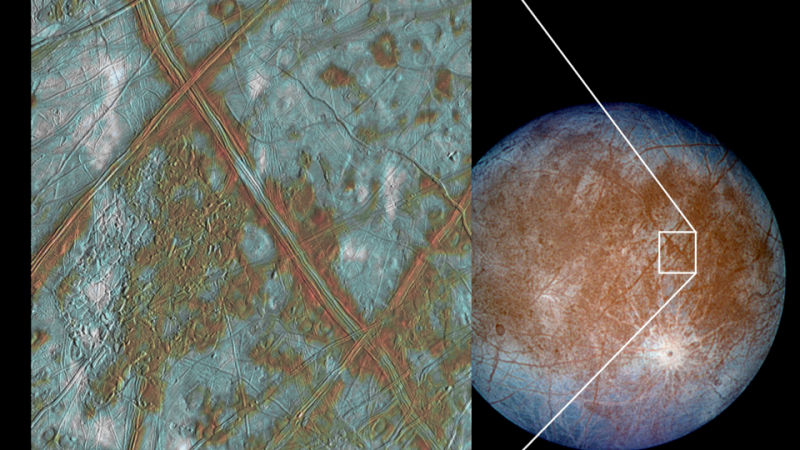
“Direct sampling of ocean of Europe represents a major technological challenge and will be possible not soon — said geobiology Caltech’s woody Fischer. But if we can take samples remaining in the zones of chaos, they have much to reveal about the composition and dynamics of the ocean bottom”. I believe that the ocean can be at a depth of 100 kilometers. Chaos (chaos terrain) in this case is a term used in planetary Geology to describe areas on the surface of celestial bodies with chaotic terrain. Such areas are composed of a disorderly combination of ridges, cracks, plateaus and other types of structures. Found them on Mars and on Europa.
Jupiter’s moon Europa, believed to hide vast salt-water ocean under its icy shell and the ocean, scientists say, has the potential to support life. Not so long ago NASA offered to send to the icy moon mission with the purpose of finding components that could indicate a life. But where best to look?
A recent study by the Caltech team, including Mike brown, Professor of planetary astronomy and Professor. Richard and Barbara Rosenberg, and Kevin Hand, astrobiology and planetary scientists at the jet propulsion Laboratory of NASA, has shown that the best place to look can be excised, the uneven surface of the so-called “chaos” of Europe.
“If you imagine a place in Europe, where ocean water is recently melted and threw chemicals on the surface, this would be it. If we ever take the samples and katalogisieren found there chemistry, we will be able to discover what was happening on the ocean floor and of Europe, we might find organic components that will be interesting.”
“We knew for a long time that the fresh icy surface of Europa, which is covered with cracks and ridges, and which changes the elevation is an external signature of huge internal salt-water ocean, brown said. — The area of chaotic terrain show the signature of large ice slabs that were broken, changed positions and once again froze. These regions are of particular interest, because water from the oceans below were able to rise to the surface through cracks and leave the deposits there. It could have a lot to tell about the activity at the boundary between solid core and ocean.”
In search of such deposits, the scientists took a fresh look at data taken in 2011 at the Keck telescope in Hawaii with the help of a spectrograph OSIRIS. The spectrographs split the light into its component parts and then measure their frequency. Each chemical element has a unique light-absorbing characteristics, spectral bands. Spectral pattern, which is obtained in the absorption process light at a certain wavelength, can be used to identify the chemical composition of minerals on the surface of Europa in reflected light.

The OSIRIS instrument measures the spectrum in the infrared wavelengths. “The minerals we expect to find on Europa, have a distinctive spectral fingerprint in infrared light, says Fisher. — Couple this with the extraordinary abilities of adaptive optics on the Keck telescope, and get a very powerful tool.” Mechanisms of adaptive optics to reduce blurring caused by turbulence in the earth’s atmosphere, due to the distortion measurement image of the bright star or laser and mechanical correction.
OSIRIS observations produced a range of more than 1600 individual points on the surface of Europa. To make this dataset a sense, Fisher has developed a new technique for sorting and identification of major groups of spectral signatures.
“Patrick has developed a very clever new mathematical tool that allows you to take a collection of spectra and automatically, without any human preconceived beliefs, to classify them according to the number of different spectra,” says brown. This software was able to compare these readings with the map of the surface of Europe, created during the mission NASA Galileo, part of the map of the Trojan satellites since the late 90s. the result is a visual guide on the composition of the regions in which was interested the team.
The analysis revealed three different categories of composite spectra. The first is water ice, prevailing on the surface of Europa. The second category included chemicals formed when ionized sulfur and oxygen — possibly from volcanic activity of the moon IO, which is nearby, is bombard the surface of Europa and react with the local ice. These data are consistent with the results of the previous work done by brown, and the other Hand to identify the surface chemistry Europe.
But the third group of chemical indicators was more interesting. She did not meet neither ice nor sulfur groups, and cannot easily be distinguished from saline minerals, as would be expected on the basis of prior knowledge about Europe. Magnesium, as believed, is on the surface, but has a weak spectral signature, and this third set of testimony is not consistent with something that you already knew about Europe. “In fact, it does not match any salty material that has previously been associated with Europe,” says brown.
When this third group was put on the surface, it got chaotic terrain. “I looked at maps of the third group of the spectrum and found that it mostly corresponds to regions of chaos, marked on the images “Galileo”. It was a startling discovery, says Fisher. — The most important result of this study was the understanding that these materials are native to Europe, because they are clearly associated with areas of recent geological activity”.
The composition of these sediments is still not defined. “We think it’s the salt remaining after a large number of oceanic waters flowed to the surface and then disappeared”. Brown compares these regions with their earthly counterparts. “It can be as large salt flats in desert regions of the world, in which the chemical composition of the salt reflects all the materials are dissolved in water until its complete evaporation”.
